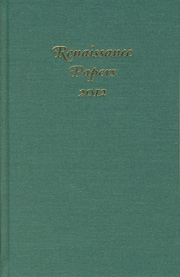Book contents
- Frontmatter
- Contents
- Dedication
- Reconstructing the Bower of Bliss: Homoerotic Myth-Making in The Faerie Queene
- Ovid, Lucretius, and the Grounded Goddess in Shakespeare's Venus and Adonis
- The Soul as Commodity: Materialism in Doctor Faustus
- Antipholus and the Exorcists: The Acts of the Apostles in Shakespeare's The Comedy of Errors
- Paul's Cross Churchyard and Shakespeare's Verona Youth
- The Summoning of Hamlet and Lear
- “Bred Now of Your Mud”: Land, Generation, and Maternity in Antony and Cleopatra
- Cosmetic Blackness: East Indies Trade, Gender, and The Devil's Law-Case
- From One Marvell to Another: Puritan Logic in “To His Coy Mistress”
- “An Heap Is Form'd into an Alphabet”: Thomas Blount's Sociable Lexicography
- Getting Past the Ellipsis: The Spirit and Urania in Paradise Lost
The Summoning of Hamlet and Lear
Published online by Cambridge University Press: 05 December 2013
- Frontmatter
- Contents
- Dedication
- Reconstructing the Bower of Bliss: Homoerotic Myth-Making in The Faerie Queene
- Ovid, Lucretius, and the Grounded Goddess in Shakespeare's Venus and Adonis
- The Soul as Commodity: Materialism in Doctor Faustus
- Antipholus and the Exorcists: The Acts of the Apostles in Shakespeare's The Comedy of Errors
- Paul's Cross Churchyard and Shakespeare's Verona Youth
- The Summoning of Hamlet and Lear
- “Bred Now of Your Mud”: Land, Generation, and Maternity in Antony and Cleopatra
- Cosmetic Blackness: East Indies Trade, Gender, and The Devil's Law-Case
- From One Marvell to Another: Puritan Logic in “To His Coy Mistress”
- “An Heap Is Form'd into an Alphabet”: Thomas Blount's Sociable Lexicography
- Getting Past the Ellipsis: The Spirit and Urania in Paradise Lost
Summary
Summoning provokes the psyche's most momentous unfoldings. The mental and visceral impact of a legal summons is obvious to all who receive one, unleashing a flood of piteous self-justification and sharp questioning of the Rule of Law. No one likes being called to judgment. To the discomfort of social courts Shakespeare's summonings add a spiritual burden. Because King Hamlet was killed as he slept, when his sinful soul was unready, his anxious ghost vanishes at cock-crow “like a guilty thing / Upon a fearful summons” (1.1.154–55). King Lear, distraught at lost power and public humiliation, allies his voice with heavenly thundering (“Close pent-up guilts, / Rive your concealing continents and cry / These dreadful summoners grace”), but he denies that the thunder summons him: “I am a man / More sinned against than sinning” (3.2.57–60).
Each play begins with a king, or a kingly wraith, summoning children for judgment, and each king's spectacular enactment of sovereignty goes terribly wrong. The “fearful summons” and “dreadful summoners” carry deep irony in that each king—one secretly slain, one publicly shamed—clings to an illusory summoner-power after having been quite defanged. Old Hamlet's ghost is “majestic” in complete armor.
- Type
- Chapter
- Information
- Renaissance Papers 2012 , pp. 53 - 66Publisher: Boydell & BrewerPrint publication year: 2013



